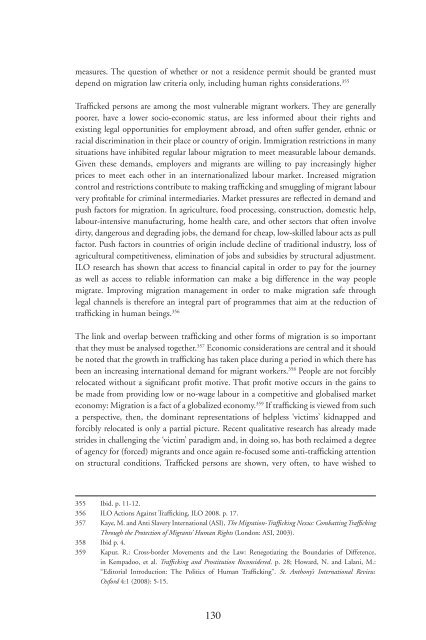Trafficking in human beings: human rights and ... - unesdoc - Unesco
Trafficking in human beings: human rights and ... - unesdoc - Unesco
Trafficking in human beings: human rights and ... - unesdoc - Unesco
Create successful ePaper yourself
Turn your PDF publications into a flip-book with our unique Google optimized e-Paper software.
measures. The question of whether or not a residence permit should be granted must<br />
depend on migration law criteria only, <strong>in</strong>clud<strong>in</strong>g <strong>human</strong> <strong>rights</strong> considerations. 355<br />
Traffi cked persons are among the most vulnerable migrant workers. They are generally<br />
poorer, have a lower socio-economic status, are less <strong>in</strong>formed about their <strong>rights</strong> <strong>and</strong><br />
exist<strong>in</strong>g legal opportunities for employment abroad, <strong>and</strong> often suffer gender, ethnic or<br />
racial discrim<strong>in</strong>ation <strong>in</strong> their place or country of orig<strong>in</strong>. Immigration restrictions <strong>in</strong> many<br />
situations have <strong>in</strong>hibited regular labour migration to meet measurable labour dem<strong>and</strong>s.<br />
Given these dem<strong>and</strong>s, employers <strong>and</strong> migrants are will<strong>in</strong>g to pay <strong>in</strong>creas<strong>in</strong>gly higher<br />
prices to meet each other <strong>in</strong> an <strong>in</strong>ternationalized labour market. Increased migration<br />
control <strong>and</strong> restrictions contribute to mak<strong>in</strong>g traffi ck<strong>in</strong>g <strong>and</strong> smuggl<strong>in</strong>g of migrant labour<br />
very profi table for crim<strong>in</strong>al <strong>in</strong>termediaries. Market pressures are refl ected <strong>in</strong> dem<strong>and</strong> <strong>and</strong><br />
push factors for migration. In agriculture, food process<strong>in</strong>g, construction, domestic help,<br />
labour-<strong>in</strong>tensive manufactur<strong>in</strong>g, home health care, <strong>and</strong> other sectors that often <strong>in</strong>volve<br />
dirty, dangerous <strong>and</strong> degrad<strong>in</strong>g jobs, the dem<strong>and</strong> for cheap, low-skilled labour acts as pull<br />
factor. Push factors <strong>in</strong> countries of orig<strong>in</strong> <strong>in</strong>clude decl<strong>in</strong>e of traditional <strong>in</strong>dustry, loss of<br />
agricultural competitiveness, elim<strong>in</strong>ation of jobs <strong>and</strong> subsidies by structural adjustment.<br />
ILO research has shown that access to fi nancial capital <strong>in</strong> order to pay for the journey<br />
as well as access to reliable <strong>in</strong>formation can make a big difference <strong>in</strong> the way people<br />
migrate. Improv<strong>in</strong>g migration management <strong>in</strong> order to make migration safe through<br />
legal channels is therefore an <strong>in</strong>tegral part of programmes that aim at the reduction of<br />
traffi ck<strong>in</strong>g <strong>in</strong> <strong>human</strong> be<strong>in</strong>gs. 356<br />
The l<strong>in</strong>k <strong>and</strong> overlap between traffi ck<strong>in</strong>g <strong>and</strong> other forms of migration is so important<br />
that they must be analysed together. 357 Economic considerations are central <strong>and</strong> it should<br />
be noted that the growth <strong>in</strong> traffi ck<strong>in</strong>g has taken place dur<strong>in</strong>g a period <strong>in</strong> which there has<br />
been an <strong>in</strong>creas<strong>in</strong>g <strong>in</strong>ternational dem<strong>and</strong> for migrant workers. 358 People are not forcibly<br />
relocated without a signifi cant profi t motive. That profi t motive occurs <strong>in</strong> the ga<strong>in</strong>s to<br />
be made from provid<strong>in</strong>g low or no-wage labour <strong>in</strong> a competitive <strong>and</strong> globalised market<br />
economy: Migration is a fact of a globalized economy. 359 If traffi ck<strong>in</strong>g is viewed from such<br />
a perspective, then, the dom<strong>in</strong>ant representations of helpless ‘victims’ kidnapped <strong>and</strong><br />
forcibly relocated is only a partial picture. Recent qualitative research has already made<br />
strides <strong>in</strong> challeng<strong>in</strong>g the ‘victim’ paradigm <strong>and</strong>, <strong>in</strong> do<strong>in</strong>g so, has both reclaimed a degree<br />
of agency for (forced) migrants <strong>and</strong> once aga<strong>in</strong> re-focused some anti-traffi ck<strong>in</strong>g attention<br />
on structural conditions. Traffi cked persons are shown, very often, to have wished to<br />
355 Ibid. p. 11-12.<br />
356 ILO Actions Aga<strong>in</strong>st Traffi ck<strong>in</strong>g, ILO 2008. p. 17.<br />
357 Kaye, M. <strong>and</strong> Anti Slavery International (ASI), The Migration-Traffi ck<strong>in</strong>g Nexus: Combatt<strong>in</strong>g Traffi ck<strong>in</strong>g<br />
Through the Protection of Migrants’ Human Rights (London: ASI, 2003).<br />
358 Ibid p. 4.<br />
359 Kapur, R.: Cross-border Movements <strong>and</strong> the Law: Renegotiat<strong>in</strong>g the Boundaries of Difference,<br />
<strong>in</strong> Kempadoo, et al. Traffi ck<strong>in</strong>g <strong>and</strong> Prostitution Reconsidered. p. 28; Howard, N. <strong>and</strong> Lalani, M.:<br />
“Editorial Introduction: The Politics of Human Traffi ck<strong>in</strong>g”. St. Anthony’s International Review.<br />
Oxford 4:1 (2008): 5-15.<br />
130

















